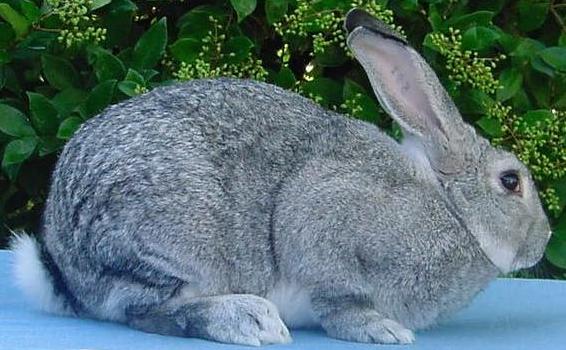Type the name of the breed you're looking for below
[wpdreams_ajaxsearchlite] Don't see the breed your're looking for? Click here and let us know!
Breed Characteristics
1 paw - breed exhibits the least amount of this characteristic
5 paws - breed exhibits most amount of this characteristic
American Chinchilla rabbit
| Origin | The American Chinchilla. Standard commercial type. Standard commercial weight. Standard commercial colour? No way. ARBA’s Standard of Perfection for this breed contains the phrase: “color is to resemble real chinchilla.” What does that mean? The colour is to look just like that of those cute little rodents you see in exotic pet stores, the Chinchilla lanigera. That is, a rich, varied, sparkling blend of black and white. The colour is produced by a banded hair shaft – each hair has bands of black and pearl-gray pigment. At a show, judges are supposed to consider the colour quality of each band, as well as their definition from each other, and the overall look of the top coat. The American Chinchilla’s coat is a lengthy rollback – an ideal length of 1 ¼ inches. Coats under 1 inch in length are faulted, as well as coats that are so long they resemble wool. Fur is to be smooth and glossy. Fur and color together pack more points in the standard than the body type, which is to be the same as other commercial breeds such as the Californian. The American Chin was developed primarily for the fur trade. When the chinchilla color first appeared in France in 1913, breeders saw the potential for profit by breeding rabbits for their coats, since the pelts of the chinchilla rodent were so valuable. The first chinchilla rabbits were of the breed we now call Standard Chins – weighing only 5-7 pounds. As soon as they hit the United States in 1919, breeders started working towards a larger version of the breed, to be more useful for meat and pelt production. Their new breed, the “Heavyweight Chinchilla” was accepted by the ARBA in 1924. The name was soon changed to American Chinchilla – possibly because a giant version of the breed was already in development. Two decades after the “Belgian Hare Boom” of 1900, which kicked off the rabbit fancy in this country, the chinchillas were by far the most popular breeds. A record-breaking 17,328 American Chins were registered with the ARBA between November 1928 and November 1929. Large commercial operations were set up to produce and sell the rabbits in mass. In the 1940’s, however, the bottom fell out of the fur market. Today the American Chinchilla is considered rare by the American Livestock Breeds Conservancy, but it still has a healthy following both among show breeders and those who raise it in the backyard for the family table. |
Physical Attributes
| Weight | 9 - 12 lbs.(4.1 - 5.4 kg.) |
| Ear Type | Erect |
| Fur Type | Rollback |
| Colours | The color is produced by a banded hair shaft – each hair has bands of black and pearl-gray pigment. |
| Appearance | Medium length body with well rounded hindquarters. Base of each hair is slate blue. intermediate band id pearl, top band is black. Ears are long and upright. |
| Other Considerations | Life Expectancy: 5-8 years Temperament: Gentle |
| Best Kept In | Pen. Cage or Yard. |



